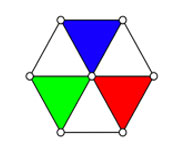


 تاريخ الرياضيات
تاريخ الرياضيات
 الرياضيات في الحضارات المختلفة
الرياضيات في الحضارات المختلفة 
 الرياضيات المتقطعة
الرياضيات المتقطعة
 الجبر
الجبر
 الهندسة
الهندسة 
 المعادلات التفاضلية و التكاملية
المعادلات التفاضلية و التكاملية 
 التحليل
التحليل
 علماء الرياضيات
علماء الرياضيات |
Read More
Date: 13-2-2022
Date: 15-2-2022
Date: 22-1-2022
|
Given a hereditary representation of a number 

](https://mathworld.wolfram.com/images/equations/GoodsteinSequence/Inline3.svg)


![B[b]](https://mathworld.wolfram.com/images/equations/GoodsteinSequence/Inline6.svg)


 |
 |
 |
(1) |
 |
 |
 |
(2) |
so bumping the base from 2 to 3 yields
=3^(3^(3+1))+3^(3+1)+3.](https://mathworld.wolfram.com/images/equations/GoodsteinSequence/NumberedEquation1.svg) |
(3) |
Now repeatedly bump the base and subtract 1,
 |
 |
 |
(4) |
 |
 |
 |
(5) |
 |
 |
-1=3^(3^(3+1))+3^(3+1)+2](https://mathworld.wolfram.com/images/equations/GoodsteinSequence/Inline23.svg) |
(6) |
 |
 |
-1=4^(4^(4+1))+4^(4+1)+1](https://mathworld.wolfram.com/images/equations/GoodsteinSequence/Inline26.svg) |
(7) |
 |
 |
-1=5^(5^(5+1))+5^(5+1)](https://mathworld.wolfram.com/images/equations/GoodsteinSequence/Inline29.svg) |
(8) |
 |
 |
-1=6^(6^(6+1))+6^(6+1)-1](https://mathworld.wolfram.com/images/equations/GoodsteinSequence/Inline32.svg) |
(9) |
 |
 |
 |
(10) |
 |
 |
-1](https://mathworld.wolfram.com/images/equations/GoodsteinSequence/Inline38.svg) |
(11) |
 |
 |
 |
(12) |
etc.
Starting this procedure at an integer 




Borwein, J. and Bailey, D. Mathematics by Experiment: Plausible Reasoning in the 21st Century. Wellesley, MA: A K Peters, pp. 34-35, 2003.
Goodstein, R. L. "On the Restricted Ordinal Theorem." J. Symb. Logic 9, 33-41, 1944.
Henle, J. M. An Outline of Set Theory. New York: Springer-Verlag, 1986.
Simpson, S. G. "Unprovable Theorems and Fast-Growing Functions." Contemp. Math. 65, 359-394, 1987.



|
|
|
|
لصحة القلب والأمعاء.. 8 أطعمة لا غنى عنها
|
|
|
|
|
|
|
حل سحري لخلايا البيروفسكايت الشمسية.. يرفع كفاءتها إلى 26%
|
|
|
|
|
|
|
جامعة الكفيل: شراكتنا مع المؤسّسات الرائدة تفتح آفاقًا جديدة للارتقاء بجودة التعليم الطبّي في العراق
|
|
|